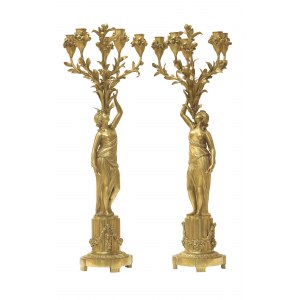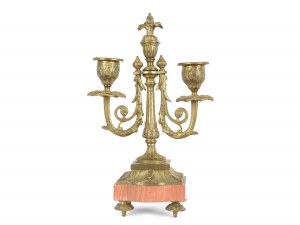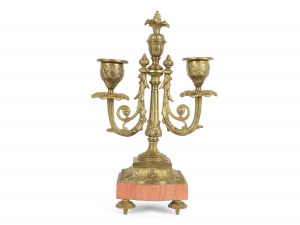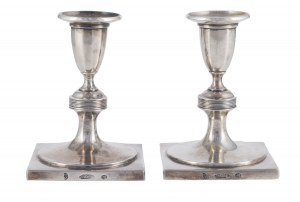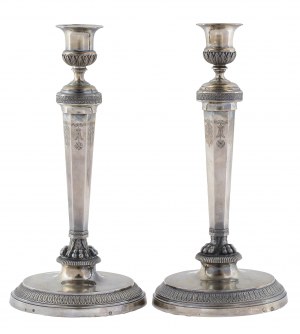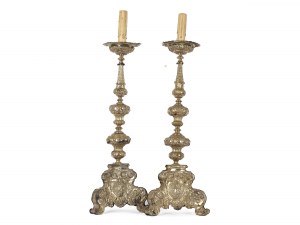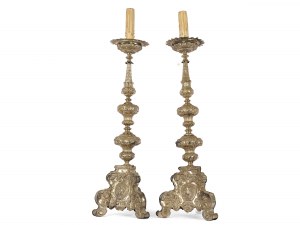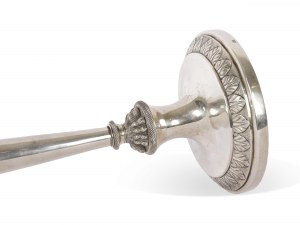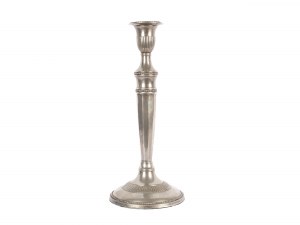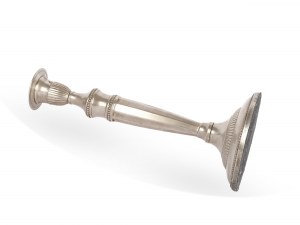cast bronze, gilded, chiseled, height 63 cm
signed BR. ŁOPIEŃSCY ⇂ WARSAW
Provenance:
pre-1939 collection of Prof. Wacław Błażej Orłowski (1868-1949) in Vilnius (attached bill of the Łopieńscy Brothers company dated 12.11.1909).
after 1949 collection of the collector's heirs, Poland
State of preservation: repair of arm, completed profitka.
Candelabra in the form of a woman clad in antique robes, holding a bouquet of flowers - this is one of the most famous designs by Etienne-Maurice Falconet (1713-1791), a famous sculptor and designer. This design was realized in several variants by European bronze factories, hence it was also included in the offer of Lopienski Brothers, the world-famous Warsaw bronzers. Distinguished by the excellent quality of the casting, as well as the elaboration of the carving and gilding, the luxurious pair of candelabra was commissioned by Professor Waclaw Orlowski, a well-known physician and bacteriologist, a researcher of rabies. The professor's collection also included other gilt bronzes made by the company.
The bronzes decorated exquisite interiors throughout the 19th century and until World War II, testifying to the position and prestige of their owner. To this day, on the world art market, they are among the most sought after works of artistic craftsmanship by collectors. They value most highly the Lopienskis' products from the company's heyday, which lasted until the outbreak of World War II. Due to the quality of their workmanship, the time of their creation and their documented excellent provenance, the offered pair of candelabra has special collector and museum value.
Lopienski Brothers is one of the most famous Polish bronze companies of the turn of the century and the interwar years. At the beginning of the last century, the Warsaw factory was considered the largest bronze factory west of Berlin. The beginnings of the company were connected with the person of Jan Łopieński (1838-1907), who founded the "Bronze Products Factory" on Ordynacka Street in 1862. In 1878, Lopienski received a medal at the Paris Exhibition. The following year, however, he was forced to join the company due to financial problems. Six years later, independent activities under the banner of "G. Lopienski" was started by Jan's sons, brothers Gregory (1867-1939) and Felix (1866-1941), who were excellently trained in the craft. By the end of the 19th century, their company was growing rapidly. Its products were very popular; in every Warsaw home there had to be at least one item from the Lopienskis. In 1900 the brothers moved their workshop to 55 Hoża Street, where they built a modern foundry. Around the same time they formed the "Lopienski Brothers" company, whose shareholder in the early days was also their brother Ignacy (1865-1941), a famous graphic artist and medalist. Together with his sons, Jan also worked. Hence, the Lopienskis indicated 1862 as the founding date of the company, recognizing their partnership as a continuation of their father's business.
During the long years, the Lopienskis were repeatedly honored for their products with the highest awards, both at domestic exhibitions (e.g. the Exhibition of Industry and Agriculture in Warsaw, 1872) and abroad (to name a few: 1879 - Paris Art Exhibition - silver medal, 1903 - St. Petersburg Art and Industry Exhibition - Grand Prix). In addition to bronzes, they also made high-end silverware. Both decorative and utilitarian objects and sculptures were created here (including Anotni Godebsky, Jozef Gabovich, Czeslaw Makowski, Antoni Kurzawa, Slawomir Celinski).
The best period of development of the form ended with the outbreak of World War I. Cut off from the Russian market and the impoverishment of society - affected the nature of production. Instead of luxurious bronzes and silverware, cheaper objects began to be created, nevertheless of the highest quality. Among their most important productions from this period are monuments (including Ludwika Nietzschowa's Mermaid from Powiśle, the monument to Bolesław Chrobry for Gniezno, J. Dietl chiseled by X. Dunikowski in Cracow, Jan Kiliński in Warsaw, Maria Curie-Skłodowska for the Radium Institute in Warsaw). Prominent designers, including Henryk Grunwald, also worked with the company at the time.
In the mid-1930s, the company was taken over by the next generation of brothers, Gregory's sons Tadeusz (1898-1983), Wladyslaw (1895-1945) and Zdzislaw (1901-1955). After World War II, Lopienski's company cast and repaired Warsaw monuments damaged during the war. However, after completing this order, it was nationalized before the authorities in 1950. In its place, the Decorative Bronze Work Cooperative was established. Tadeusz Lopienski resumed his activity in 1957, when he established an artistic bronze workshop located at 24 Poznańska Street. It is currently run by his daughter Anna Lopienska-Lipczyk and her husband, Wojciech Lipczyk.



